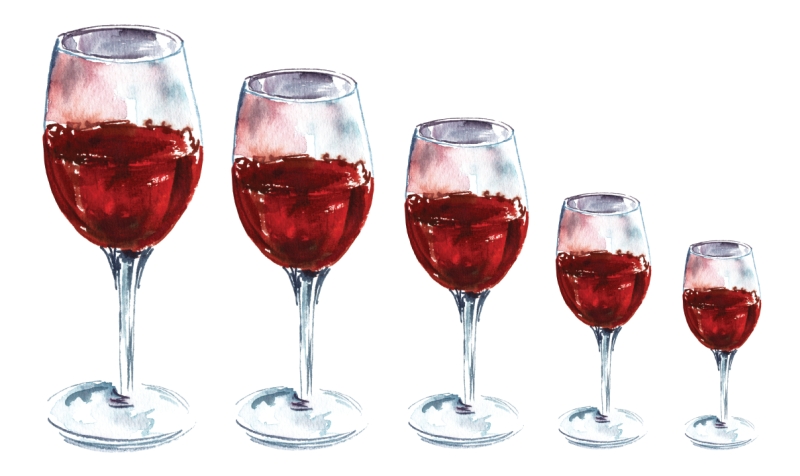Wine lovers, I have found, are unrepentant collectors, not only of bottles of wine, but also all the paraphernalia that goes along with wine — the labels, corkscrews, corks and even those little metal discs under the cage of champagne bottle stoppers. And, of course, they collect wine books.
I confess that I was an avid wine book collector until I moved into a condo and had to divest myself of some 700 volumes. It was like giving away children. But there was one book I parted with years ago that I still think about as a bittersweet memory. It was the cellar book for Queen Mary’s Dolls’ House at Windsor Castle. Its beige, hard cover bore the name “Berry Brothers & Rudd,” the renowned London-based wine merchant.
To be clear, the collector’s item, which I had found in a second-hand bookshop in London, was not the actual cellar book that resides in the wine cellar of the dollhouse. Rather, it was the template that was used to miniaturize the volume to the size of a postage stamp — to be in perfect proportion (one inch to the foot) with all the other contents of what has been described as “the world’s largest and most beautiful dolls’ house.”
If ever you chance to have tea at Windsor Castle, ask the Queen about her grandmother’s palatial, four-storey doll’s house. She will tell you, no doubt, that it was designed in 1924 by the British architect Sir Edwin Lutyens, who took time off from another project – building New Delhi – to indulge the royal whim.
Queen Mary, the wife of George V, was by all accounts a voracious and rapacious collector of miniatures. According to a contemporary, “Her methods of collecting were notoriously ruthless: she would admire an object so relentlessly and so forcefully that its owner felt obliged to hand it over. Prudent hostesses hid their favourite things before she arrived.”
The fruits of Queen Mary’s hyperactive collector gene can be seen in this most remarkable artifact. The dolls’ house contains a host of miniature items that actually function: “There are Purdey’s shotguns that ‘break and load’ (and may even fire), monogrammed linens ... electricity and lifts, a garage of cars with engines that run. It even has running water through its tiny pipes.”
Equally extraordinary is the wine cellar in the basement. The bottles are half an inch tall, each stoppered with cork and sealing wax and labelled with reproductions of real labels. They were filled with the actual wines — First Growth clarets and Montrachet. The Veuve Clicquot Champagne bottles each have their own straw sleeve.
“The entire cellar amounts to 22 cases of Champagne, ten cases of claret, 14 cases of port, four cases of sherry, two cases of Madeira, four cases of white burgundy, two cases of Sauternes, two cases of Graves, two cases of red burgundy and two cases of hock; then it’s on to brandy (four cases), gin (four cases), rum (one case) Scotch whisky (one quarter cask and 13 cases), Irish whiskey (ditto), French vermouth (two cases), Italian vermouth (two cases), liqueurs (seven cases) and beer (17 cases and two casks).”
Much of this was handwritten into the cellar book that I had in my possession; and I wanted to find out if it was indeed the model for the Q ueen’s dolls’ house cellar book. So, some 40 years ago, I took it down to Berry Brothers & Rudd, Britain’s oldest wine merchant at No. 3 St. James Street. The facade looks exactly as it must have looked when the store was opened by “the Widow Borne” in 1698.
No. 3 St. James Street has changed little since the widow opened shop as a purveyor of coffee to the London clubs. The coffee scales and the mill are there still, along with records of customers’ weights spanning three centuries.
Anthony Berry, the then director, told me that the handwritten entries were made by his late father, who had been commissioned by the Palace to lay down the cellar for the dolls’ house. He eyed the volume with the same kind of acquisitive desire that Q ueen Mary must have experienced when she happened on a miniature that she wanted for her collection.
Looking around at this magnificent old building I thought that the cellar book really should be here — so I presented it to Anthony Berry. Now Berry Brothers has a magnificent selection of old ports, and I was thinking that he might just reward me with a bottle for my gift.
“Thank you, old boy,” he said to me. “And I would like you to accept this.” He reached behind and took a book from the shelf. It was a history of No. 3 St. James. He even signed it.
It was one of the wine books that I divested myself of when I moved to the condo.
Tony Aspler is the author of 17 books on wine, including his latest, Canadian Wineries.
I confess that I was an avid wine book collector until I moved into a condo and had to divest myself of some 700 volumes. It was like giving away children. But there was one book I parted with years ago that I still think about as a bittersweet memory. It was the cellar book for Queen Mary’s Dolls’ House at Windsor Castle. Its beige, hard cover bore the name “Berry Brothers & Rudd,” the renowned London-based wine merchant.
To be clear, the collector’s item, which I had found in a second-hand bookshop in London, was not the actual cellar book that resides in the wine cellar of the dollhouse. Rather, it was the template that was used to miniaturize the volume to the size of a postage stamp — to be in perfect proportion (one inch to the foot) with all the other contents of what has been described as “the world’s largest and most beautiful dolls’ house.”
If ever you chance to have tea at Windsor Castle, ask the Queen about her grandmother’s palatial, four-storey doll’s house. She will tell you, no doubt, that it was designed in 1924 by the British architect Sir Edwin Lutyens, who took time off from another project – building New Delhi – to indulge the royal whim.
Queen Mary, the wife of George V, was by all accounts a voracious and rapacious collector of miniatures. According to a contemporary, “Her methods of collecting were notoriously ruthless: she would admire an object so relentlessly and so forcefully that its owner felt obliged to hand it over. Prudent hostesses hid their favourite things before she arrived.”
The fruits of Queen Mary’s hyperactive collector gene can be seen in this most remarkable artifact. The dolls’ house contains a host of miniature items that actually function: “There are Purdey’s shotguns that ‘break and load’ (and may even fire), monogrammed linens ... electricity and lifts, a garage of cars with engines that run. It even has running water through its tiny pipes.”
Equally extraordinary is the wine cellar in the basement. The bottles are half an inch tall, each stoppered with cork and sealing wax and labelled with reproductions of real labels. They were filled with the actual wines — First Growth clarets and Montrachet. The Veuve Clicquot Champagne bottles each have their own straw sleeve.
“The entire cellar amounts to 22 cases of Champagne, ten cases of claret, 14 cases of port, four cases of sherry, two cases of Madeira, four cases of white burgundy, two cases of Sauternes, two cases of Graves, two cases of red burgundy and two cases of hock; then it’s on to brandy (four cases), gin (four cases), rum (one case) Scotch whisky (one quarter cask and 13 cases), Irish whiskey (ditto), French vermouth (two cases), Italian vermouth (two cases), liqueurs (seven cases) and beer (17 cases and two casks).”
Much of this was handwritten into the cellar book that I had in my possession; and I wanted to find out if it was indeed the model for the Q ueen’s dolls’ house cellar book. So, some 40 years ago, I took it down to Berry Brothers & Rudd, Britain’s oldest wine merchant at No. 3 St. James Street. The facade looks exactly as it must have looked when the store was opened by “the Widow Borne” in 1698.
No. 3 St. James Street has changed little since the widow opened shop as a purveyor of coffee to the London clubs. The coffee scales and the mill are there still, along with records of customers’ weights spanning three centuries.
Anthony Berry, the then director, told me that the handwritten entries were made by his late father, who had been commissioned by the Palace to lay down the cellar for the dolls’ house. He eyed the volume with the same kind of acquisitive desire that Q ueen Mary must have experienced when she happened on a miniature that she wanted for her collection.
Looking around at this magnificent old building I thought that the cellar book really should be here — so I presented it to Anthony Berry. Now Berry Brothers has a magnificent selection of old ports, and I was thinking that he might just reward me with a bottle for my gift.
“Thank you, old boy,” he said to me. “And I would like you to accept this.” He reached behind and took a book from the shelf. It was a history of No. 3 St. James. He even signed it.
It was one of the wine books that I divested myself of when I moved to the condo.
Tony Aspler is the author of 17 books on wine, including his latest, Canadian Wineries.





